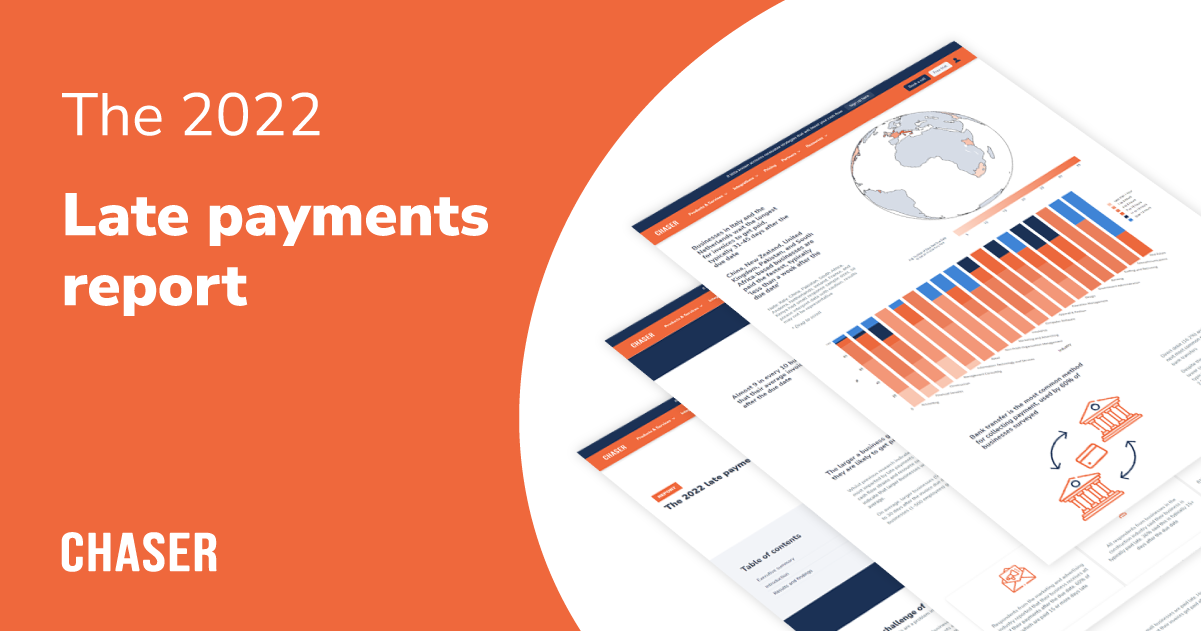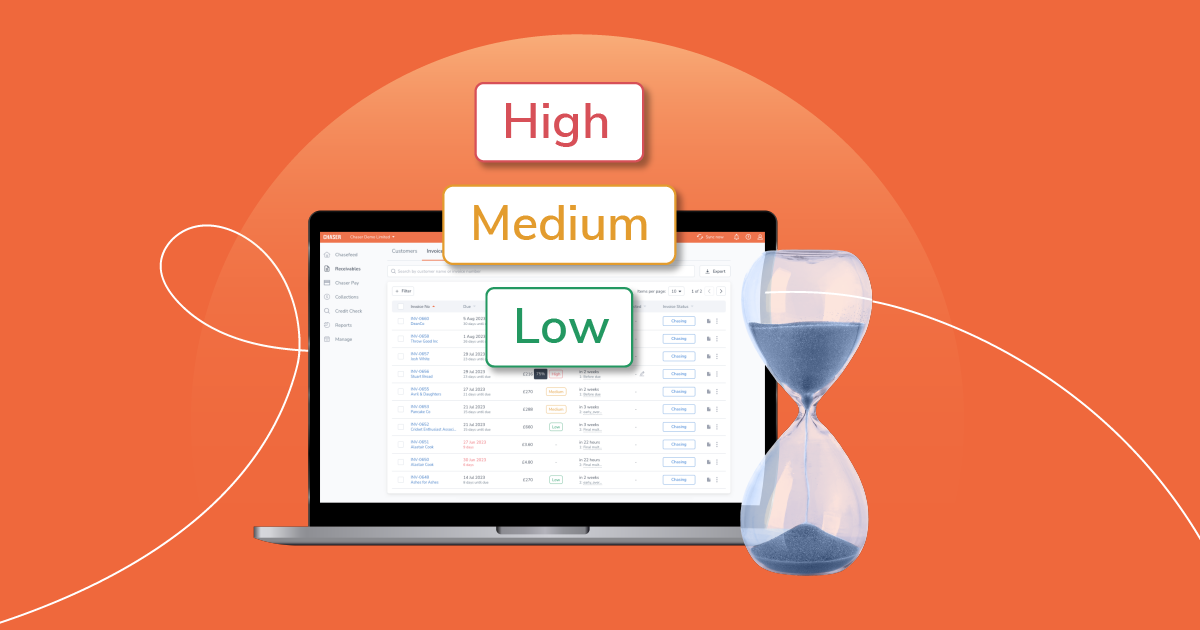Late payments have become one of the most pressing challenges faced by businesses today.
Small and Medium enterprises (SMEs), usually defined as those with annual sales of less than £5 million, are particularly vulnerable to late payments. In fact, late payments are one of the leading causes of SME failure.
Around 50,000 businesses are pushed into insolvency each year in the UK alone as a direct result of late invoice payments, according to research by the FSB. To put that in context, SMEs in the UK account for 99.5% of all private-sector businesses and 60% of all employment, which means that late payments have a significant impact on the economy as a whole.
This is an issue faced by businesses globally, with mid-sized businesses in the US reporting that they were owed on average $304,066 by late-paying customers - and 81% of those businesses reporting that these late payments had become more severe since 2021. Late payments also place a sizeable time burden on businesses, with mid-sized businesses in the US spending on average 14 hours per week following up on overdue invoices.
The knock-on effect of this is that cash flow is constrained, and businesses are forced to dip into their own reserves or take out loans to stay afloat – both of which come at the risk of long-term financial stability.
The challenges faced by businesses in response to late payments are significantly heightened by difficult economic conditions. During COVID-19 and the ensuing recession, 40% of businesses saw worsening late payments, and insolvencies doubled. With the looming threat of a global recession, it is imperative that businesses take stock of late payment challenges they are facing and adopt practical solutions to avoid and reduce them.
It is clear that late payments present a huge issue for businesses across the globe, and that in the current macroeconomic conditions, finance leaders need to be aware of late payments and the threats they can present to their businesses.
The 2022 late payments report explores the issue of late payments in-depth, including:
- The severity of late payments
- The time cost of late payments
- The accounts receivables workload
- Accounts receivables processes and methods used, and their impact on payment times
- Recommendations to reduce late payments
The 2022 late payments report assesses the current global severity of late payments, how they can be reduced, and what methods businesses have implemented to deal with them. These findings can help your business to understand the scale of the problem and provides ideas on how to address it in your own business.
The severity of late payments
Data drawn from The 2022 late payments report shows that late payments are prevalent, with 87% of businesses reporting that they are typically paid after their invoice due date.
Below are some key insights on the severity of late payments discovered in the report, for the full findings download The 2022 late payments report.
- Almost 9 in every 10 businesses report that their average invoice will be paid after the due date
- Just 13% of respondents reported getting paid on time, or before their invoice due date
- Businesses in China, New Zealand, The United Kingdom, Pakistan, and South Africa-based businesses are paid the "fastest," only having to wait a week after their invoice due date on average
Of the sectors surveyed in the report, the marketing, advertising, and construction industries reported the most issues with late payments, with 60% reporting that their invoices are typically paid 15 or more days late.
While the issues that late payments cause for SMEs are well-documented, largely because of their limited resources and existing cash flow strains, large businesses are not immune to the problem of late payments.
In fact, the survey revealed that, while smaller businesses can expect payment one to two weeks after the invoice due date, those businesses that have grown enough to have more than 500 employees typically have to wait up to 30 days after the invoice due date for payment.
However, there are solutions available to cut down on the length of time businesses need to wait for payments. The survey found that accounts receivables software users are three times more likely to get an invoice paid before the due date. With the support of software and automation in the invoice follow-up and accounts receivables process, businesses like FHC and Docuflow have been able to reduce late payments by 54 days.
Almost 9 in every 10 businesses report that their average invoice will be paid after the due date
The time cost of late payments
The cost of late payments extends well beyond the value of the invoice itself; businesses also have to factor in the time and resources it takes to chase payments.
According to the survey:
Over half of businesses are spending 4 hours or more on payment follow-up tasks every week
This is time that could instead be spent on developing new products or services, marketing the business, or raising investments.
The late payment crisis is therefore not only having a financial impact on businesses, but also a significant opportunity cost, particularly to smaller businesses with fewer internal resources to dedicate to dealing with late payments and accounts receivables tasks.
The hardest hit industries also spend the most amount of time chasing late payments.
- 30%+ of respondents from the Construction, Financial Services, and IT industry report that they spend 7 or more hours per week managing accounts receivables tasks per week
Seven hours per week adds up to over 360 hours per year. That’s the equivalent of 9 work weeks. So, not only are businesses paying a significant opportunity cost, but they are also forgoing other important tasks to deal with their late payments.
Ultimately; time spent dealing with late payments means less time spent on revenue-generating activities.
The accounts receivables workload
In The 2022 late payments report, over a quarter of businesses admitted to struggling to keep on top of their accounts receivables tasks every month.
Businesses in the Computer software, Retail, Accounting, and Construction industries are among the industries most likely to struggle to keep on top of accounts receivables tasks
There are notable consequences to not being on top of your accounts receivables workload, the report shows that:
- Businesses that follow up with 70% or fewer of their invoices are more likely to receive payments 31-45 days after their invoice due date
- Businesses that follow up with 90% or more of their invoices are the most likely to get paid within a week of their invoice due date
- Using a combination of SMS invoice payment reminders and email payment reminders increases a business's chance of getting paid within a week of the invoice due date by 56%
What we can take from this is that following up on invoices is crucial to getting paid on time. Automation and software can help to reduce the time burden that staying on top of late payments can present.
By sending an automatic, polite, and personalised message to all customers with outstanding invoices, TaxAssist Norwich was able to get £20,000 paid for one of their clients in just 30 minutes. This case study also demonstrates the benefit of taking a proactive approach to late payments can have. Just one email can bring your debtor book down by £20k.
Automated reminders can take the form of emails and SMS payment reminders, they can be scheduled to go out at regular intervals until the invoice is paid. This not only saves the accounts receivables or finance department time but also increases the chances of getting paid sooner.
Processes and methods in accounts receivables
The research shows that the processes and methods of accounts receivables play a key part in the efficiency of receivables management and reducing late payments.
As explored, using a combination of SMS and email reminders increases a business’ chance of getting paid within a week of the invoice due date by 56% - compared to using email payment reminders alone.
- 93.8% of businesses report using email payment reminders to chase invoices
- 60% of respondents follow up on late payments over the phone
- However, less than 25% had branched out into other channels, such as SMS payment reminders or WhatsApp invoice reminders
One of the benefits of using SMS messages is they have higher open rates than email (98%, compared to 20-30% for email), meaning your customers are more likely to see open your payment reminder message.
It's important to remember that every business is different, and what works for one organisation might not work for another. The key is to experiment with new processes and find what reduces days sales outstanding and helps your team reach their accounts receivables goals.
Automation also plays a huge role in alleviating the burden of late payments on the finance team or accounts receivables department. There are a number of software solutions that can automate the accounts receivables process, from issuing invoices to sending reminders and even making phone calls. These solutions can save a huge amount of time and increase efficiency.
In conclusion, effective management of accounts receivables is essential for any business. It's important to find what works best for you and your business and to automate as much of the process as possible. With the right tools and processes in place, you can ensure that your accounts receivables are managed effectively and efficiently.
The 2022 late payments report
What The 2022 late payments report makes clear is that late payments and the challenges they present for businesses are widespread. As businesses struggle with the effects of a looming global recession, cash flow management has become increasingly challenging.
There are a number of factors that contribute to invoices becoming overdue and various reasons for payments being delayed, including
- Customers who are themselves struggling financially and are unable to pay their bills on time
- Delays in getting invoices processed by the customer's accounting department
- Customers who dispute the charges on their invoices
- Missing or incorrect details on their invoice
Whatever the reason, late payments can have a major impact on a company's cash flow. And, if left unchecked, they can quickly become a serious problem. Fortunately, there are steps businesses of any size, in any industry, can take to reduce late payments and improve accounts receivable performance.
Based on findings in The 2022 late payments report about how businesses are effectively reducing late payments and the negative impacts on their business, the following recommendations are suggested.
Take a proactive approach to credit management
Taking a proactive approach to credit management is one of the best ways to reduce late payments. By monitoring customer payment patterns and implementing credit controls, businesses can avoid many of the common causes of late payments.
Some key credit management practices include:
Input a credit control policy
Particularly for large businesses having a standardized credit control or accounts receivables policy in place is important because it sets out the rules and procedures that must be followed in order to manage credit risk. The policy should be reviewed and updated regularly in line with changes in business circumstances.
As mentioned, larger businesses tend to be paid slower than small businesses, so it’s important for big companies to factor this in when setting their credit control policy.
Leveraging late payment fees and interest can help to motivate customers to pay on time and also offset some of the costs associated with late payments.
Offering discounts for early payment can also be effective in encouraging prompt payment, while still allowing you to get paid sooner than if the customer took advantage of the full credit period.
Remind customers before their invoice is due
A passive approach to late payments is unlikely to be effective, so it’s important to take a proactive approach to credit control.
This means sending reminders to customers before their payment is due, rather than simply waiting for them to remember.
Don’t just react to late payments. Taking a proactive approach means reaching out to your customer before your payment is late and sending before-due payment reminders. As explored, before-due payment reminders can also be sent via text.
This approach allows you to check in with your customer ahead of their invoice due date and address any potential issues early on, rather than waiting for the payment to be late and then trying to chase it up.
It also shows your customers that you are serious about getting paid on time and that you value their business.
Utilize best practice advice
Given how widespread the issue of late payments is, there is a lot of advice and guidance out there on how to deal with it.
One of the best sources of advice is from other businesses who have been in your position and have overcome the problem. Visit The 2022 late payments report to see how businesses in your industry, and your business size are currently impacted by and approaching late payments.
There are also plenty of articles, blog posts, and guides written on the subject. Visit Chaser’s blog and resources center containing a wealth of ready-to-use PDF guides, whitepapers, and templates to support your receivables process.
Some key pieces of advice are:
- Keep on top of your invoices and follow up as soon as they become overdue
- Maintain good records of all your correspondence with customers, including phone calls and emails
- Use clear and concise language in your invoices, invoice payment reminders, and other communication
- Be firm but polite in your dealings with customers
If you’re struggling with late payments, there is always help and support available. Chaser offers advice webinars in the following territories each month for exactly that:
These webinars connect you with other businesses and expert advisors, so you can learn from each other and get the latest information on dealing with late payments.
You’ll also get the following:
- Practical tips for dealing with late payments
- Advice on how to avoid late payments in the future
- Information on your legal rights when it comes to chasing payments
- The opportunity to ask questions and get advice from experts
Try new channels of communication
Using a combination of SMS and email reminders increases a business's chance of getting paid within a week of the invoice due date by 56%
By supplementing emails or phone calls with SMS payment reminders via text you can increase the likelihood of receiving timely payment.
SMS reminders are also a great way to reduce the number of phone calls your staff needs to make each day, saving valuable time and resources.
It’s important to be creative when finding ways to collect payments. This means trying new things and being open to different methods of communication. You never know what might work best for your business and your customers.
If you’re looking for a way to improve your payment collection process, consider using SMS payment reminders. They could be the key to getting paid on time, every time.
Reduce your workload with automation
Businesses that follow up with 90% or more of their invoices are the most likely to get paid within a week of their invoice due date.
As we mentioned, the administrative burden of collections can be significant. If you’re struggling to keep up, consider automating your collections process.
Chaser offers a suite of tools to help you get paid on time, including credit checking, automated payment plans, a payment portal, and automatic text and email payment reminders. The implementation of these tools can save you valuable time and energy in the collections process, and in reducing late payments at your business.
By supporting your accounts receivables team with automated software, you can ensure you stay on top of what’s due when, reduce late payments, and improve cash flow
To find out more about how Chaser can help you automate your collections process, book a demo today or try our 14-day free trial. No credit card required.
For more insights on late payments and how to reduce them, download The 2022 late payments report.





